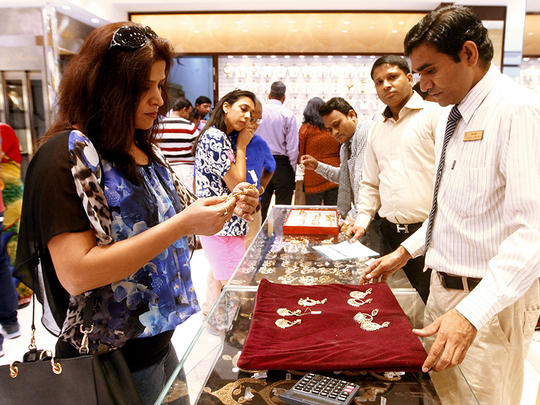
Dubai: The Indian Finance Minister wants Indians to whet their gold appetite using bullion and jewellery that is already available within their home market and rely less on overseas markets such as the UAE. But Arun Jaitley may not have much luck when it comes to jewellery sales.
There is no move in the latest budget to cut the 10 per cent import duty on gold, and because of this, Indians — expats and those on a visit — buying gold in the UAE/Gulf will continue to get a substantial cost advantage from doing so. (Apart from the 10 per cent, there is also the additional sales tax that individual Indian states impose on retail jewellery sales.) “The variation in gold prices remains the same, which is about 7-9 per cent higher in India,” said Joy Alukkas, Chairman and Managing Director of Joyalukkas Group.
I was widely assumed in the days leading up to the budget presentation that the duty would be cut, even to 5 per cent. The Commerce Ministry itself had made such a recommendation.
“The maintenance of the duty at 10 per cent means gold will continue to be over 10 per cent cheaper in countries like the UAE,” said Abdul Salam K. P., Executive Director at Malabar Gold & Diamonds. “It will also mean an impact on the import of jewellery from elsewhere into India — this will affect the availability of internationally designed and manufactured jewellery.
“Customers will, therefore, find a much larger array of designs and jewellery in the Gulf.” An Indian woman on an overseas visit can bring back Rs100,000 (Dh5,958) worth of jewellery back into India. It is Rs50,000 for a man. India imports between 800-1,000 tonnes each year, and last year regained its status as the world’s leading importer, pushing China to second spot after the hiatus in 2013.
However, it is important to note it would become exorbitant to buy gold from outside of India only if the rupee fell well below Rs70 to the dollar.
Dollar reserves
According to industry sources, India has outlived its need to retain the gold import duty at 10 per cent, which was imposed after deficit widened in 2013-14 and the dollar reserves were running dangerously low in early 2014. That status no longer exists, with dollar reserves now well over $300 billion.
But other specific proposals to better tap Indian’s gold consumption patterns find favour with leading jewellery chains which operate networks in India and the Gulf.
In particular, the “Gold Monetisation Scheme” finds favour with them.
“The Scheme will help convert the physical asset to a liquid financial asset,” said T. S. Kalyanaraman, Chairman and Managing Director at Kalyan Jewellers. “The proposed gold coins with the Ashoka Chakra will also encourage recycling of gold among domestic consumers and give a fillip to “Make in India”.
“The resolve of the government to discourage cash-based transactions augurs well. However, the implementation will have to be in a phased manner considering the fact that a significant class of consumers of gold and jewellery, especially in rural India, may not have a PAN (permanent account number) card and are yet to be integrated into the nationalised banking network.
“This move may trigger more purchase from the unorganised sector leading to a loss to the exchequer. Therefore, it is imperative the Government introduce a stringent implementation framework, which ensures compliance.”
The proposal for gold bonds is another that Indian jewellery chains have taken a shine to. “The bond will be an alternative to buying the metal,” said Alukkas. “We might also see some deduction in gold prices in India when gold deposit accounts are implemented to utilise the tonnes of gold available in the country.
“These might in the longer run cut imports of the bullion into India.”












